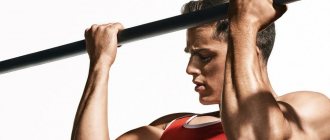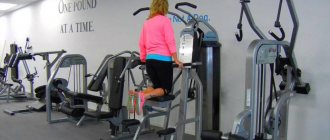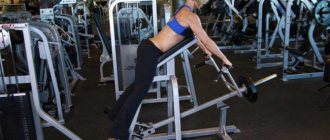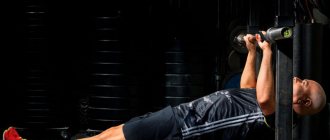• You may also be interested in: “Handstand for beginners”
You should know that: - kipping and its sister butterfly are one of the most controversial exercises; — kipping pull-ups in the same ratio to strict pull-ups as the “shvung” press to the “military” press; - if you can’t do pull-ups strictly, then you shouldn’t “kip”; - if your goal is to build muscle mass, then kipping pull-ups will not help you achieve this; - Kipping can be used for hypertrophy. After failing on strict pull-ups, you can finish off your back with a couple of kipping pull-ups; — you only need to be able to do butterfly pull-ups if you are a competitive CrossFitter and they suit you. If there is a variation of pull-ups that is most dangerous for injury, it is most likely the butterfly.
What are kipping pull-ups?
Kipping pull-ups are a type of pull-up in which your hips and legs swing and use momentum to help you pull yourself up. This significantly reduces the load on your hands.
There is also an advanced version called the butterfly pull-up, which uses constant motion to produce even faster pull-ups. In this case, a larger array of muscles and movement impulse are used to move the body in space.
For competitive CrossFitters, kipping helps them get more reps in less time. This does not violate the rules of their sport in any way, so for them it is quite an exercise. Well, for guys who want to gain more “meat” and increase strength, should they do this exercise? Is it safe? And most importantly, do you need to learn how to do it?
Secrets of an Elite Swimmer
Hips rise as arms plunge into water
This is RULE NUMBER ONE. When rowing movements are performed untimely and irregularly, their effectiveness drops sharply; if the moments for the stroke with the arms and the kick with the feet are chosen incorrectly, the forces are applied in opposite directions. To coordinate the movements, just remember that your hips should rise as your arms plunge into the water.
Use T-Zone Countermeasures
The resistance of the “T” zone is directed against the force that pulls us under water (“T-zone” is formed by the intersection of the longitudinal axis of the body with a conditional line connecting the armpits). We will use the counteraction of these forces for balancing. Under natural conditions, the torso and hips move relative to each other in the same way that a child's swing balances around a central point. The T-zone resistance will make it easier to lift your hips as your arms plunge into the water.
Connect your head
The body always follows the head. Remember that the head has a certain mass, and, accordingly, inertia. If you try to lift your head too high (to inhale), your body will immediately try to follow it in an attempt to fly. But the reasonable application of this energy, like the counteraction of the T-zone, will help maintain balance.
Place your hands correctly
When starting your hand stroke, place your hands in the water in front of you, shoulder-width apart or at a slightly greater distance from each other. A very wide grip literally holds less water, but a very narrow grip requires significant energy expenditure.
Keep your elbows high
During the stroke, what is called a catastrophic “elbow drop” can occur. It is very likely that the elbows will go down and be located below the hands (and significantly below the surface of the water) at the beginning of the pull-up phase, when the arms are far away from the body
Focus on keeping your elbows “outward” and near the surface, above your hands. This will allow you to make an energetic stroke with all the muscles of your arms instead of a sluggish and ineffective stroke with your elbows.
Chest hit and hit the bottom of the pool
The butterfly stroke is not performed at the knee joint or at the ankle. If you have seen dolphins soar above the water and whales swim, you have probably noticed that they move using a single and indivisible wave-like movement that begins in the head, through the entire body to the tail and ends with a powerful blow. The real butterfly is similar to this. Imagine the kick starting from the chest and this will help you maintain proper balance. When mastering butterfly, always remember two rules. First, the rowing movement should be built in the correct sequence, namely:
- Balance
- Body position taking into account the position of the head and chest
- Hip movement
- Rowing movement of the arms
To learn how to maintain proper body position, you can try some training exercises such as one-arm swimming and combining strokes (a few flying strokes and quickly switching to breaststroke).
The second rule is to take your time and be consistent. If you're just starting to learn butterfly, limit yourself to a couple of strokes in shallow water. As you acquire and consolidate the skills of rowing movements, gradually increase the distance, each time by the same amount. And very soon you will be surprised to find that people call you a natural swimmer.
Kipping and pressing "shvung"
Kipping is related to a strict pull-up in the same way that a push press is related to a “military” press.
In both the kipping and push press, you use the momentum created by the lower body to assist the movement of the upper body. That is, the stronger the impulse you give with your lower body, the easier it will be for your upper body. And it will be easier to lift more weight or do more repetitions.
So is the shwung press a cheating or a type of bench press? One thing I am sure of is that in both cases, the person performing these exercises will either look super athletic, focused and powerful, or they will look like they are having a seizure.
I really like the high snatch, which is very similar to the kipping pull-up: you use your lower body to create as much momentum as possible so you don't have to strain your arms as much. Am I cheating too?
Kipping is not cheating
A true kipping pull-up is not just a cheat pull-up. This is a fairly complex technical movement. The correct kipping technique requires the athlete to have endurance, strength and coordination. Especially when performing several pull-ups in a row (that is, without a pause in the bottom position between repetitions), and all these qualities are needed even more when performing the butterfly.
The same can be said about the press “shvung”. This is not just a “military” bench press with cheating. A very precise movement that requires a certain body position and good endurance. You need to use your hands at the right moment - not earlier, not later.
Few people criticize the push-up press; so far, kipping pull-ups receive more angry letters. And it's strange. In both cases, you do one thing - use momentum to help your upper body complete the rep.
When we talk about these exercises, we're talking about compound movements. In two cases, those who do them incorrectly will appear epileptic and increase the risk of injury. But if both pull-ups are done correctly, then they are safe.
Maybe it’s because kipping was popularized by crossfitters, and the push press by weightlifters? It seems to me that now every hardcore poser feels obligated to hate CrossFitters. Although for me there is no difference. Anyway, I'm not saying that CrossFit kipping pull-ups are a good exercise and everyone should do them. Also, I’m not saying that the push press can and should be done by everyone without exception.
Useful tips
Those who are just starting to pump their abs using a horizontal bar should always listen to the advice of experienced athletes in order to get good results and avoid damage. To do this, you need to strictly follow all the rules. First of all, when practicing on the bar, you should remember the need for the correct grip. It must be as strong and reliable as possible to avoid injury. For this purpose, the thumb is located at the bottom to ensure maximum secure fixation. In addition, you need to monitor proper breathing. It is necessary to raise your legs as you exhale and lower them as you inhale. Never perform exercises on the abdominal bar using jerks, as this can lead to injury. You should exercise smoothly at a slow pace. Lifting the legs should be done strictly using the muscles. That is, you don’t need to strain your arms, as you will sway.
Techniques for pumping up the abdominals on the bar:
Raising the legs to the horizontal bar. This exercise involves raising your legs until they touch the bar. In this case, you need to firmly hold onto the horizontal bar with your hands. After lowering, you need to slowly return to the original position using the abdominal muscles as intensively as possible.
It is important to ensure that the body does not sway, otherwise the workout will not be performed correctly. If it is difficult for someone to do such exercises, then you can do a simpler technique
To do this, hang on the horizontal bar and bend your knees
Next, you need to press your legs to your chest and then straighten them parallel to the floor. Subsequently, you should try to stay in the pose with your legs raised to the bar
To do this, hang on the horizontal bar and bend your knees. Next, you need to press your legs to your chest and then straighten them parallel to the floor. Subsequently, you should try to stay in the pose with your legs raised to the bar.
Exercise frog. Its essence is to pull the knees to the chin from a hanging position. After tightening your knees, you need to try to fixate in this position for as long as possible. This technique is well suited for pumping up the lower abdominal muscles. It is advisable to do them at least five approaches, gradually increasing their number to ten or more.
Upper abs workout. If you want to work on your upper abs, then you should do this exercise regularly. To do this, you need to hang on the crossbar upside down and secure yourself well. Next, the athlete pulls the body towards the knees and lingers in this position for several seconds.
Exercises for the oblique abdominal muscles. This technique is quite complex, so it may not be suitable for beginners. Its essence is that you need to hold on to the horizontal bar and raise your legs straight up. Next, turn your legs from one side to the other, like a kind of clock.
Thanks to all these techniques, you can quickly and quite effectively pump up your abdominal muscles using a horizontal bar.
History of the bale
Kipping pull-ups were designed to achieve the required number of unbroken reps faster than an athlete who would do strict pull-ups. In fact, people in gyms have been doing them for quite a long time, but they were not called kipping, but simply pull-ups with a slight rocking of the pelvis.
When CrossFit competitions began, the rules for pull-ups stated that the athlete must somehow get his chin over the bar. Coming out of this, cheating pull-ups were allowed. And athletes who manipulated the rules to achieve maximum advantage developed the more complex kipping pull-ups we see today.
Nowadays, you will rarely see an athlete at a CrossFit competition who chooses to do “strict” pull-ups, especially if the routine does not indicate this. At first, kipping pull-ups didn't bother anyone, since they were only performed by top-level athletes who can do a ton of strict pull-ups. Kipping simply helped them finish their WOD faster.
They were made by athletes who had well-developed muscles around the shoulder joint. These muscles could absorb the pressure created by performing kip pull-ups.
Problems appeared when CrossFit went mainstream. Very often, beginners do not have the muscle corset and shoulder mobility to perform kipping pull-ups safely. But what caused the real problems was that even those who were quite weak (individuals who could not do one or two strict pull-ups) could do kipping pull-ups once they learned proper pelvic movement.
But even if you can do it, doesn't mean you should!
Let's go back to the comparison with the push press. If someone is weak and can't hold a 30kg barbell over their head without looking like they're lifting in an earthquake, then they probably shouldn't be allowed to do push presses.
Of course he will be able to lift the barbell over the head thanks to the push of the legs, but the possibility of injury will be high due to the catastrophe that can occur in trying to hold the barbell. Likewise, a person who cannot do strict pull-ups will do kipping.
Problems of horizontal bar lovers
Pull-ups are a rather traumatic thing, especially if you haven’t done anything before. Beginners should choose rubber-coated platforms, or horizontal bars that are dug directly into the sandbox, so as not to be injured if they fall. And it is quite real, especially if there are problems with the grip and exorbitant ambitions that do not allow a person to stop training in time.
In addition, the practitioner should always have magnesium on hand to prevent slipping, calluses and damage to the skin.
Injuries
The main way to prevent injury is to normalize your relationship with your own ego. Stop trying to force jump jumps if you don't know how to do a pull-up yet. Do not perform exercises using the force of inertia if you do not yet have enough muscle strength. Try to do everything technically and complete tasks gradually.
Well, here are the classic recommendations - first warm up by lightly running around the site, then by rotating in all the main joints, after that by pulling the rubber to your chest with the shock absorber secured on top.
Calluses
The reason for their occurrence is not excessive work, or even sweaty palms. Usually, calluses plague those who really like to hang on their fingers, and even swing at the same time. From the very first training, learn to make a palm grip so that the body does not sway from side to side and does not perform pendulum movements. This will help get rid of callus problems. If your training volume is high and you are using weights, feel free to use straps. A good grip is great, but regular training without pain and calluses is even better.
In general, some “roughness” of the palms is the norm, and it only helps to stay on the horizontal bar.
Ligament pain
Here it is necessary to distinguish between inflammation of the ligaments and joints, which are dangerous to health, and muscle soreness. Soreness is a normal practice, and it cannot harm your training in any way. On the contrary, you should actively warm up on days that are not heavy training.
But if the ligaments and joints hurt at night, become inflamed, or seem to “tug” when you are at rest, it is better to consult a doctor to rule out health problems.
Falls from the horizontal bar
This is also normal practice; you need to learn to jump softly and onto the surface. But in fact, most often those who do not use magnesium and who have a weak grip fall from horizontal bars. The second category of athletes must simply develop their grip. If the metal of the crossbar is smooth and slippery, it is worth wrapping a medical plaster around the crossbar to ensure normal adhesion to the coating.
First the “strict” ones!
You shouldn't do kipping until you can do a decent number of strict, full-range pull-ups, starting from a sticking point at the bottom and ending with a slight pause at the top. How much is “decent amount”? At least five. Doesn't sound "decent" enough? Try it first. Start with a hang, then pull yourself up without any inertia, place your chin over the bar, hold for 2 seconds. Then lower yourself back under control into a hanging position and repeat 4 more times.
It's a lot harder than it looks.
It is not enough to just pull yourself up; you must control your body at all stages of the movement - both in lifting and in lowering. If you can't do that, then you can't do kipping.
Preparatory exercises
Before learning the kipping technique, you need to master 2 basic hangs on the bar:
- boat
- arch
boat
Free hang. Any grip width. Bring your legs straight forward, 10-15 degrees. The abs are tense. Hold this position for 10-20 seconds.
Arch
Free hang. The grip width is arbitrary. Bend at the waist. tighten your buttocks and back of your thighs. Extend your legs straight back. Hold for 10-20 seconds.
When and how to start doing kipping pull-ups?
I am not an expert in kipping and do not pretend to be one. Although I know everything about the human body, namely how to train it to reduce the risk of injury.
If you're a CrossFit athlete, you'll likely need to learn how to do kipping pull-ups to improve your performance. And I hope your trainer is competent enough to teach you the correct technique when the time comes. But when will this “time” come?
First you need to go through a few steps
1. You should be able to do 5 strict pull-ups - hanging position, chin over the bar, pause at the top, controlled lowering. Once you can perform several of these approaches, you can begin to learn and incorporate kipping pull-ups into your training; 2. Learn to do kipping with minimal pressure. Pause between reps, or do two, and then from the top position slowly, under control, lower yourself to a hanging position. Don't try to string together repetitions. Focus on performing each repetition correctly and lowering under control. Lowering slowly will help you build the necessary muscle core and develop movement patterns for further safe performance of the kip. You must confidently perform the approaches: precise movements, chin over the bar, pause for 1-2 seconds at the top, controlled lowering. 7-10 reps is your minimum before moving on to the next step; 3. Do strict and kipping pull-ups mixed together. First, do a set of strict pull-ups and when you no longer have any strength left, then start “boiling.” But at the same time, stay at the top and slowly lower down. When you can get 15-20 repetitions in such a combination (7 strict and 8 kip, for example), then you are ready for the next step; 4. Learn to chain pull-ups. Once you feel more confident, try to increase your speed; 5. Learn to do butterfly pull-ups. Please note that this technique is not for everyone. Some competitive CrossFitters have chosen kipping pull-ups for themselves and use them in competitions.
The longer you hold each step, the safer high-intensity kipping pull-ups will be for you.
: Negative stretches
Negative pull-ups (working only while going down) can also be an effective way to strengthen your back and shoulders. To perform them, you need to jump to lift yourself over the crossbar, and then lower yourself down smoothly and under control. The descent must last at least five seconds. No matter how strange it may seem at first glance, during the negative phase of the movement the muscles have to expend more effort than during the upward jerk, thanks to which negative pull-ups can really develop your strength.
Does kipping build muscle?
CrossFitters often become overly concerned with their unique exercises. If you tell a CrossFitter that one of their variations is not the best way to build muscle, they will take it personally. But if you tell a weightlifter that the push and jerk is not the best way to build muscle in the shoulders, he will agree with you 100%.
Noting that this exercise is not the best for gaining mass does not mean that it is bad. Try to be objective.
For those involved in competitive CrossFit, the importance of kipping pull-ups is obvious. They help you do more reps without stopping, faster, with much less upper body fatigue.
If you perform the kip correctly, namely with the help of a powerful upward push with your hips, creating momentum, then the load on the upper body will be reduced to a minimum. This type of pull-up is good for getting a lot of reps in a short period of time. But it won't suit you if you want to strengthen your upper shoulder girdle.
The kip also works well on the lats because you're doing a similar movement to a horizontal hang as you push through your hips. And if you lower yourself under control, your arms and back will be tense during the negative phase.
But to be completely honest, the value of kipping for hypertrophy is much less than that of the same strict pull-ups.
I see the point in doing kipping only when you've reached failure on strict pull-ups and want to do a couple more reps.
For example, you're doing strict pull-ups, after eight reps you feel like you can't do another strict pull-up, but if you know how to do kipping correctly, you can do a couple more. And if you lower yourself slowly after each kip, they will definitely trigger better muscle growth. It's like your partner will help you lift the barbell on the bench press a couple more times so that you can do a couple more reps when you go to failure.
So, it turns out that for athletes who want to get bigger, kipping pull-ups are a good way to complete a pull-up set, just like forced reps, negatives, or drop sets.
And if it comes to hatred and controversy, then we should remember the proverb: “Let the one who has never swung on the last sets of crunches throw the first stone.”
Pork balyk
- Time: 8 days.
- Number of servings: 20 persons.
- Calorie content of the dish: 240 kcal/100 grams.
- Purpose: snack.
- Cuisine: Turkic.
- Difficulty: easy.
Since pork is a fatty meat, the balyk made from it is high in calories. This recipe uses the neck, this part of the carcass is tender and cures well. Before using, it is better to warm the spicy mixture a little in a dry frying pan so that the spices and herbs reveal their aroma. The recipe specifies a minimum amount of spices, you can vary it to your taste.
Ingredients:
- pork (neck) – 1 kg;
- salt – 100 g;
- coriander – 20 g;
- ground black pepper – 20 g;
- paprika – 20 g;
- dried garlic – 20 g.
Cooking method:
- Rinse the meat and wipe dry.
- Roll the pork in salt, transfer to a flat dish and place under pressure on the refrigerator shelf for three days.
- Turn the meat regularly to ensure it is evenly salted.
- Drain the liquid, pat the pork dry, and rub with spices.
- Wrap the neck with gauze or other thin natural material, and tie it several times with thread.
- Hang in a warm, well-ventilated place for 5 days.
About butterfly
Butterfly is an evolved version of kipping. Remember that you need to get your chin over the bar, no matter how. Chris Speller was the first CrossFitter to use the butterfly pull-up in competition, and it has since become a staple for competitive CrossFitters.
They were created to allow you to complete more repetitions in less time. With kipping pull-ups at the top and bottom you slow down and get a second of rest. In butterfly pull-ups, you are constantly in motion. So if you can do them correctly, the butterfly will be much faster than the kip.
But not everyone is cut out for butterfly pull-ups: you have to have very strong shoulders and people with shorter arms have an advantage. Also, such pull-ups require more endurance and a sense of rhythm than kip, so athletes who have previously done gymnastics usually cope with them with an A.
The possible negative impact on the shoulder joint of the butterfly stroke is greater than that of a regular kip. Only very strong athletes with good shoulder flexibility should practice them.
This is why you see top athletes still doing kipping instead of butterfly, even though the latter is much more effective in theory. There is also a high risk of getting a “no rap” when performing the butterfly, due to the fact that you will often have to raise your chin when approaching the bar.
The butterfly stroke also works the deltoid muscles a little and can trigger their growth. But butterfly is a complex movement. And you will have to spend a lot of time and effort if your goal is only to build muscle!
Conclusions:
1. Kipping pull-ups are not the most effective way to build muscle. But it is a necessary skill to master if you want to compete in CrossFit; 2. If an athlete performing kipping pull-ups has well-developed muscles of the shoulder girdle, as well as flexibility of the latter, then this exercise is quite safe for him, or as safe as other ballistic movements such as “Olympic movements” and jumps; 3. Kipping pull-ups can be used to build muscle mass when used as an intensification of a set in which you were doing strict pull-ups, i.e. use them as forced reps or negatives at the end of a set. This should only be attempted by advanced athletes who can perform a large number of strict pull-ups and those who have mastered proper kip technique; 4. Butterfly is used in competitions because this style is faster than regular kipping. This is a very difficult movement that should not be mastered unless you are an advanced CrossFit athlete. The butterfly puts a lot of stress on the shoulders and should only be performed by athletes with a well-developed shoulder girdle and flexibility of the shoulder joint. Butterfly is the most traumatic variation of pull-ups; 5. If for some reason you want to learn how to do kipping pull-ups, you should first build up your strength by doing strict pull-ups. This will help make your shoulders stronger and also more resistant to injury.
The principle of creating a training program
CrossFit is based on three areas that train skills necessary in everyday life. The initial level of training in this case guarantees better shape, general physical fitness and health than a high level with only one of these sports.
- Weightlifting Basics (W): Squats, deadlifts, presses, cleans and snatches.
These multi-joint exercises replicate movements that we regularly perform in everyday life. They develop muscle strength, speed and power, and also affect agility, coordination and accuracy.
- Gymnastics with your own weight (G): push-ups, including handstands, parallel bars, pull-ups, rope climbs with your legs or only on your hands, power lifts in rings, corner.
These exercises are the most difficult in CrossFit. They help develop extraordinary strength. Their areas of influence include flexibility, coordination, balance and agility.
Pull-ups are one of the main exercises in CrossFit, as they carry a very important vital function - the ability to lift your own weight. Moreover, if most men can do pull-ups on the horizontal bar or parallel bars at least 2-3 times, girls often cannot do even 1 time.
In this case, rubber loops (also called CrossFit loops), which are a 4.5 cm wide tourniquet folded in the shape of a double loop, will come to the rescue. They take on some of your weight. They are attached to the horizontal bar, stood on them and then pulled up.
You can adjust the degree of tension of the projectile (this determines how much weight they take on). Start with the tightest and then loosen.
- Aerobics has added cardio (M) to CrossFit: running, jumping rope, rowing and other exercises that can be classified as general physical fitness.
The most effective types are swimming up to 400 m, cycling, running, rowing up to 1500 m. In other words, the emphasis should be on sprint distances: 200, 400, 800 m. This type of exercise trains both cardiac and muscular endurance at the same time. Long-term cardio (more than 1 mile or 1.6 km) significantly reduces muscle performance.
This system fits into the concept of interval training. The most popular are Tabata intervals: 20 seconds of training, 10 seconds of rest, performed in 6-8 approaches. Medicine ball exercises are also effective: throws or team games, for example, pioneer ball (in CrossFit it is called hooverball).
Principles of standard training
- Intensity. The complexes are designed for a maximum of 30 minutes, but they must be performed at such a speed and without rest that the training can be equated to a 1.5 hour session.
- Competition with others and yourself. It is the feeling of competition that pushes us forward to new achievements, new weights and speed of performing the complex. Stock up on a stopwatch and opponents.
- At the forefront of everything is a methodology that cannot be deviated from, regardless of the level of training. It is possible to weaken the complex, or vice versa, to increase the load only due to the speed and weight of the projectiles.
- Constantly changing the training program. Unlike the gym, it is strictly contraindicated to work on one complex for a long time. Everything needs to be changed: both the exercises and the principles of programming.
What is the essence of the CrossFit effect? This training is aimed at solving 3 problems:
- Development of basic skills – there are 10 in total:
- sense of balance;
- cardiorespiratory and muscular endurance;
- power;
- force;
- speed;
- flexibility;
- coordination;
- dexterity;
- accuracy.
A person’s preparedness is assessed by these parameters, and, therefore, CrossFit training programs should be aimed at their development both through organic changes in the body and by optimizing the functioning of the nervous system.
- Preparing the body for unforeseen difficulties . In life, you have to run not only in the morning at the stadium, but also for a bus that suddenly arrived 2 minutes earlier than usual. Daily physical activity is spontaneous, so the body must be prepared not for a specific trained load, but for any sudden one. Therefore, in CrossFit there are many variations with different principles of construction, number of repetitions, and one complex cannot be done for 2 days in a row. CrossFit expands possibilities: each exercise or complex is constantly modified without causing addiction, and accordingly the body progresses in its development.
- Activation of all energy processes . The ability to switch from one energy supply to another in order to continue to perform at your best is very important. Cardio exercises play a decisive role here.











